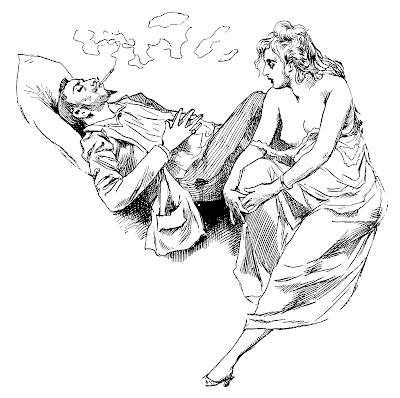Mad, Bad and Dangerous to Know - by Duncan Harley
There’s a splendidly spectacular circular hiking route around Gight over at
Methlick. Known locally as the Braes of Gight, braes they certainly are.
Plunging variously down some 300ft to the River Ythan and back up again this is
not a walk for the faint hearted and for those more used to the gentle
gradients of abandoned railway tracks the walk will fairly take your breath
away. Of course, the essence of this trail is its association with the romantic
poet, Lord Byron.
Byron's mother was of course Catherine Gordon of Gight.
‘Mad bad and dangerous to know’, the poet and adventurer and 6th Baron Byron died in April 1824 aged just 36 years. In a nod to the burial fate of the poet come artist come visionary William Blake (1757-1827), Byron was denied a final resting place amongst his literary equals at Westminster Abbey. Instead he lies buried alongside the 14th century church of Mary Magdalene’s in Hucknall.
Few, outside Aberdeenshire realise that he grew up in Aberdeen’s Broad Street and spent some more of his youth in the city’s Virginia Street before heading off to fame and fortune. Schooled at Aberdeen Grammar, where he apparently carved his initials onto a classroom desk, he has nowadays lent his name to various local businesses including a burger-chain and a local recruitment consultancy. A finely chiselled statue of the man clothed in classical attire was unveiled by the Marchioness of Huntly in 1923 and now stands in the grounds of Aberdeen Grammar School. A civic square in Aberdeen’s Northfield housing estate is named in his honour.
With somewhat uninspiring opening lines such as ‘O Thou! Who rollest in yon azure field’, ’When energising objects men pursue’ and ‘We do not curse thee, Waterloo!’ it’s a wonder that anyone reads Byron nowadays, unless forced to by academic requirements. But, despite the flowery verse his work remains popular.
He wrote of course, amongst other works Don Juan. In the classic version of the tale, Don Juan is portrayed as a wealthy Lothario and libertine who devotes his life and soul to the seduction of women. His life is also punctuated with bouts of extreme violence, instances of murder and, inevitably, lots of gambling. The tale’s ending depends on which version of the legend one reads.
Tirso’s original play has been interpreted as a religious parable warning against Don Juan’s sinful ways and ends with him dying, having been denied salvation by God.
Other authors and playwrights have interpreted the ending in their own fashion. Espronceda’s Don Felix walks into hell and to his death of his own volition, Zorrilla’s Don Juan asks for a divine pardon.
Byron’s version reverses the classic womanising image of legend, portraying the protagonist not as a womaniser, but as a man easily seduced by women. Written in some 16000 lines of romantic verse, Byron himself called it an ‘epic satire’.
Byron's mother was of course Catherine Gordon of Gight.
‘Mad bad and dangerous to know’, the poet and adventurer and 6th Baron Byron died in April 1824 aged just 36 years. In a nod to the burial fate of the poet come artist come visionary William Blake (1757-1827), Byron was denied a final resting place amongst his literary equals at Westminster Abbey. Instead he lies buried alongside the 14th century church of Mary Magdalene’s in Hucknall.
Few, outside Aberdeenshire realise that he grew up in Aberdeen’s Broad Street and spent some more of his youth in the city’s Virginia Street before heading off to fame and fortune. Schooled at Aberdeen Grammar, where he apparently carved his initials onto a classroom desk, he has nowadays lent his name to various local businesses including a burger-chain and a local recruitment consultancy. A finely chiselled statue of the man clothed in classical attire was unveiled by the Marchioness of Huntly in 1923 and now stands in the grounds of Aberdeen Grammar School. A civic square in Aberdeen’s Northfield housing estate is named in his honour.
With somewhat uninspiring opening lines such as ‘O Thou! Who rollest in yon azure field’, ’When energising objects men pursue’ and ‘We do not curse thee, Waterloo!’ it’s a wonder that anyone reads Byron nowadays, unless forced to by academic requirements. But, despite the flowery verse his work remains popular.
He wrote of course, amongst other works Don Juan. In the classic version of the tale, Don Juan is portrayed as a wealthy Lothario and libertine who devotes his life and soul to the seduction of women. His life is also punctuated with bouts of extreme violence, instances of murder and, inevitably, lots of gambling. The tale’s ending depends on which version of the legend one reads.
Tirso’s original play has been interpreted as a religious parable warning against Don Juan’s sinful ways and ends with him dying, having been denied salvation by God.
Other authors and playwrights have interpreted the ending in their own fashion. Espronceda’s Don Felix walks into hell and to his death of his own volition, Zorrilla’s Don Juan asks for a divine pardon.
Byron’s version reverses the classic womanising image of legend, portraying the protagonist not as a womaniser, but as a man easily seduced by women. Written in some 16000 lines of romantic verse, Byron himself called it an ‘epic satire’.











Comments
Post a Comment